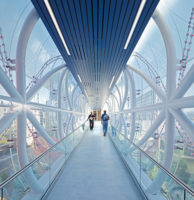A new exhibit at the Japan House in Los Angeles showcases high-concept thinking about what is possible for how cities and the natural world could coexist in the face of climate change and the natural disasters that come with it.
The “Designing with Disaster” exhibit, open through April 2, features concepts for seven “regenerative” cities able to anticipate and adapt to natural disasters such as wildfires, hurricanes and tsunamis. The exhibit is part of the Architecture and Urban Design for Disaster Risk Reduction and Resilience (ArcDR3) initiative, a global effort led by the xLAB at the University of California, Los Angeles and the International Research Institute of Disaster Science at Tohoku University in Japan.
The initiative was established as a response to the 2011 tsunami and earthquake in Fukushima, Japan, and priorities outlined in the Sendai Framework in 2015 for preventing new and existing disaster risks worldwide. Eleven Pacific Rim universities partnered with design studios to explore new ways to respond to disasters and build new disaster-resilient environments around the world. The exhibition first appeared in Tokyo in April 2022.
UCLA Professor Hitoshi Abe, who heads up xLAB and is the curator for the exhibit, says “Designing with Disaster” is meant to expose the wider public to the idea of regenerative urbanism, in which urban environments are built to work with natural processes, rather than defending against them.
According to Abe, the approach to disaster management to date has generally been to separate nature from the human environment.
The ArcDR3 initiative asks urban planners, designers and the wider public “to consider a different approach to urban resilience—replacing the pre-disaster, defensive-oriented maintenance and post-disaster rescue-and-restoration approach with one that embraces and incorporates the effects of disaster through innovative and safer urban design strategies that improve environments during everyday conditions and reduce the severity of the inevitable disaster event,” he tells ENR.
Practical Implementation
Although the concepts may seem fantastical, elements of regenerative design have already been implemented on both small and large scales.
At a Jan. 28 forum held at the museum, Momoyo Kaijima, a founder of Tokyo design firm Atelier Bow-Wow, described her efforts, along with cofounder Yoshiharu Tsukamoto, to revitalize a rural fishing village in the Oshika Peninsula in Tohoku, Japan, that was damaged by the earthquake in 2011. “Disasters can be an opportunity to reset … This is a good chance for thinking in a different way,” she said. Kaijima and Tsukamoto both helped establish ArchiAid, a group of more than 300 architects around the world that volunteers their services to help communities rebuild after natural disasters.
Shohei Shigematsu, a partner at OMA in New York City, described his work with the cities of Hoboken, N.J., and Miami to boost resilience to flooding. In Hoboken, which experienced widespread flooding in 2012 after Hurricane Sandy, Shigematsu worked with a team to design a plan to convert an asphalt-covered area into a vegetated green space to absorb, filter and store water to reduce flooding. That project is currently under construction.
In Miami, Shigematsu is working with a team to design and build a new artificial reef substrate and art sculpture to restore habitat and natural reefs that have eroded over time. The goal is to both create a piece of public art and strengthen resilience to storms. He noted that the Miami effort has involved significant public input. “Projects are becoming more and more convergences of art, finance and community engagement,” he said.
Craig Lewis, principal at CRTKL, Arcadis' architecture and urbanism business, says that many large-scale designs for urban centers may have enormous towers, or a high-concept “destination” or park where people can congregate. These places often wow the public as “an element of folly, or surprise or delight for some people,” he says.
But outside of these dazzling structures, many urban centers retain their familiar block structures because that is what people seem most comfortable with, Lewis told ENR. “The very best way that we can be resilient as a civilization is just reuse the buildings that we have in a different way.”
UCLA's Abe notes that the U.S. Housing and Urban Development's Rebuild by Design Hurricane Sandy design competition, launched in response to its devastating impacts on the eastern U.S., was a good model for research-based, collaborative processes to prepare communities for future challenges.
He says he would like to see the group of collaborators created through ArcDR3 into a permanent network. “I believe these types of initiatives have begun but will require more time and effort to mature and become effective around the world,” Abe said.










Post a comment to this article
Report Abusive Comment